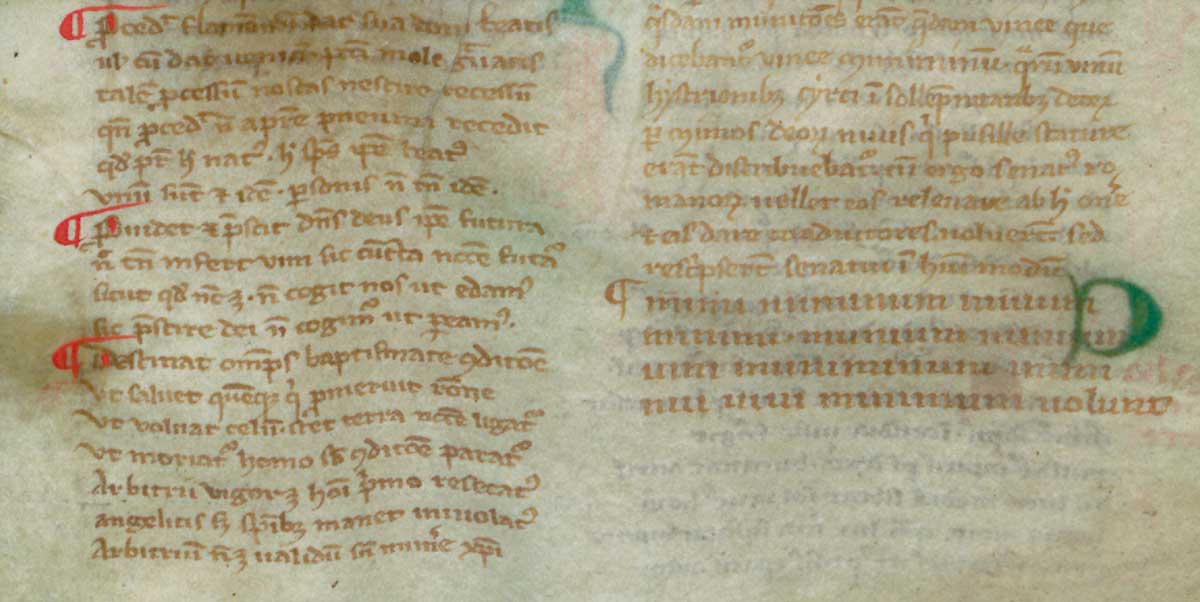Medieval Minims
The hidden meaning of a medieval pen-twister.

mimi numinum niuium minimi munium nimium uini muniminum imminui uiui minimum uolunt
While admittedly bizarre, this medieval Latin sentence is nevertheless perfectly comprehensible. It has been translated as:
The very short mimes of the gods of snow do not at all wish that during their lifetime the very great burden of (distributing) the wine of the walls to be lightened.
This mock sentence is renowned for having been written almost exclusively in m, n, u and i – letters made up of short, vertical pen strokes that are, fittingly, called minims. It often circulates out of context as an illustration of the frustrations and annoyances that medieval scribes faced when working in Gothic scripts. It is a perfect illustration of how little distinction there is between letters composed of minims in such scripts and their seeming impenetrability. On the rare occasions when context is given, the sentence is attributed, rather vaguely, to ‘medieval scribes’. It is certainly amusing to imagine professionally trained medieval scribes writing this sentence, perhaps in frustration after hours of painstaking work. The image reinforces the popular assumption that medieval life was exceptionally tedious.
But the real story is perhaps more amusing – and it offers fascinating insight into daily life in the medieval period.
The only copy of this sample sentence is found in a medieval personal miscellany, a collection of lyrics, lines of poetry and pithy sentences extracted from various sources. This type of carefully hand-curated collection was known as a florilegium – Latin for a gathering of flowers – because it contained the flowers of wisdom, carefully picked and arranged. A compiler might select ‘flowers’ for any number of reasons, including their humour, utility, or poetic beauty.
This particular miscellany seems to have been compiled by someone living in northern France in the 13th century. It is a very small booklet, just a bit larger than a smartphone (14.5 × 10.8 cm), containing only six parchment leaves (the equivalent of 12 pages).
Its contents are remarkably wide-ranging. It opens with the kinds of serious religious and moral texts we typically associate with the medieval period. These include an extract from a poem ascribed to Serlo of Wilton (c.1105-81) on the importance of shunning the material world: ‘Mundi abit res nota satis’ (‘The matter of the world changes plenty – take note!’). But the topic changes very suddenly to tips on how to write poetic descriptions taken from a widely popular medieval creative writing manual by Matthew of Vendôme, known as the Ars versificatoria (or The Art of Versification). These tips give examples of how to describe a diverse cast of characters, including a church official, a soldier and a lawyer. After this, the booklet switches back to religious themes, then offers some mnemonic devices designed to help with maths.
It is after these maths devices that the minim sentence appears. Then, in another change of subject, the booklet gives some medical guidance, including a short verse about how human urine looks thicker up close, and ends with some scathing satire of the Church and its monks and a riddle about an egg.
These contents do not seem to have been produced by a team of professional scribes. Aside from a few sections that were added later, the booklet was the work of one individual, who seems to have copied down interesting, fun, or useful material from a range of different sources. The compiler’s interests might seem rather random today, but they actually reflect the variety of topics covered by the medieval university curriculum.
‘University’, at least in the shape that we know it in the West, was relatively new in the 13th century – and it was evolving rapidly. It generally involved far less specialisation than it does today. In the course of one programme, a student could learn how to write Latin, how to compose letters, how to do simple calculations and how to perform various administrative tasks, such as producing legal agreements and keeping records. The texts in this florilegium seem to match this variety.
Against this backdrop, the minim sentence no longer appears like an illustration of the frustrations of Gothic handwriting, or of the tedium of medieval life. Nestled as it is among snippets of satire, triviality and fun, the sentence becomes a riddle that revels in the ambiguities of Gothic scripts. Much like the ‘quick brown fox’ sentence copied by students today for containing all the letters of the alphabet, the minim sentence highlights the remarkable possibilities of language. While Gothic handwriting tends to be associated with the drab mundanity of medieval life, the texts in this booklet plainly show how medieval life could be punctuated by moments of light humour, trenchant social critique and joy.
Krista A. Murchison is an assistant professor of medieval literature at Leiden University, Netherlands.